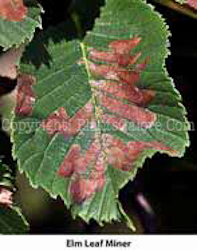 Some
insects eat almost anything green while others are very
specific about the plants they infest. Elm leaf miners
fall into the latter group since they only chew on
members of the genus,
Ulmus.
Some
insects eat almost anything green while others are very
specific about the plants they infest. Elm leaf miners
fall into the latter group since they only chew on
members of the genus,
Ulmus.
The term "leaf miner"
describes a tiny insect that burrows between the upper
and lower layers of a leaf. Generally, an adult, flying
form lands on the leaf and lays and egg just beneath the
surface tissue. The egg hatches and a worm-like larvae
begins to feed between the layers.
As the larvae grows, the "mine" becomes larger and the
surrounding plant tissue dies and turns a translucent
brownish color. Eventually, if held up to the light, you
can see the larvae and its tiny, pellet shaped droppings
inside the mine.
Eventually, the larvae makes a transformation into a fly
adult form. This over winters and comes back in the
spring to lay its eggs on the new leaves to start the
whole process again.



